Essential Information
Tandem Skydiving: A Beginners Guide
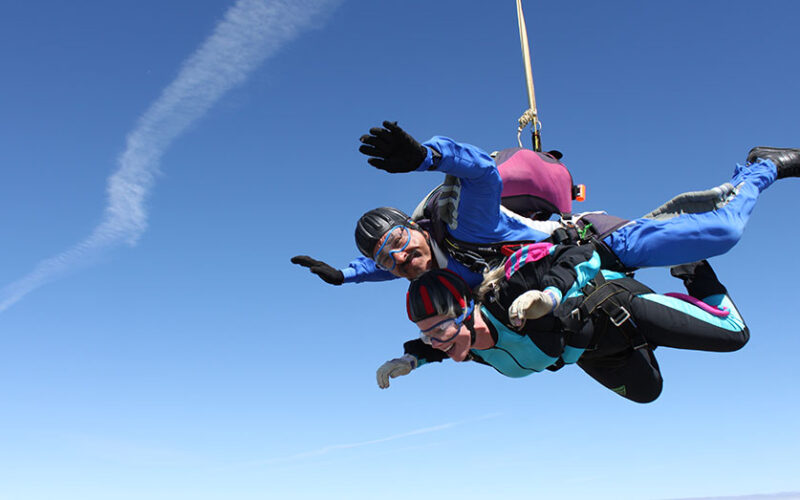
This article is a complete introduction to tandem skydiving for a curious beginner skydiver. Learn what a tandem is, what makes it the preferred method of first time skydiving and the practices that keep this thrilling experience safe.
Table of Contents
What is a tandem skydive?
Tandem skydiving or tandem parachuting is a method of skydiving where a student skydiver is connected to a rated instructor called a tandem master. As a pair, the two make a complete skydive which includes jumping from a plane, freefall, canopy flight, and a parachute landing. This type of skydiving was developed and adopted during the 1980’s and quickly became the primary method of first time skydiving.
Benefits of Tandem Skydiving as a First Jump
There are many reasons why tandems are the preferred type of first jump. Notable advantages include:
- No previous skydiving knowledge required.
- Minimal student training required. You can be ready to jump in as little as 30 minutes.
- The tandem master is responsible for operating the parachute system which allows for full enjoyment of the experience by the student.
- Tandem skydives can be filmed and photographed to document the experience.
- Tandems are the safest way to introduce a new jumper to the sky.
- Perfect for those looking to cross skydiving off their bucket list as a one-time experience or as an introduction to pursue skydiving as a sport.
Tandem Skydiving vs Skydiving Training Programs
If you’re looking to become an experienced skydiver, you’ll likely participate in a static line (IAD) or accelerated freefall (AFF) course. These multi-jump courses can require up to 8 hours of training before a first jump. They are not used as a one-and-done, bucket list method of skydiving.
Many people ask if tandem skydiving is the only method of first jump available. The answer is technically no. It is possible to start with a student program, but we rarely if ever recommend it. Even if you’re 100% certain you’re looking to become an experienced jumper, a tandem is the best first step into the sport.
A low-responsibility tandem jump is ideal for soaking in the overwhelming first jump experience. Some skydiving facilities even use tandem skydives as part of an experienced skydivers progression by performing ‘working tandems’. This hybrid style of training uses tandem jumps to introduce the skydiving student to various responsibilities before transitioning to solo jumps.
It is also worth noting that documented tandem jumps count towards the 25 jumps required for an experienced skydiver’s A-License. Performing a tandem is always a good investment and your money never goes to waste.
Who can go tandem skydiving?
To be able to make a tandem jump, you’ll need to meet some age and weight requirements. You’ll also need to be in good enough physical condition to handle the stresses of freefall and canopy flight. These restrictions are not enforced to discriminate but are in-place for the safety of everyone involved.
Tandem Skydiving Age Limit
Physics says that as long as you can securely fit in a harness, you can safely make a tandem. Despite this, the local laws of each country and state determine what age you legally must be to make a skydive. In the USA and most other parts of the world, the minimum age to make a tandem skydive is 18 years old.
These rules are in place to protect the tandem student and the dropzone. These limits are also enforced by the United States Parachute Association (USPA) – the organization that oversees skydiving in the USA and around the world.
There are some exceptions to the rule in various parts of the world where jumpers younger than 18 years old are allowed:
| Country | Minimum Age to Skydive |
| Australia | 12 yrs old |
| France | 16 yrs old |
| Germany | 12 yrs old |
| New Zealand | No minimum age |
| South Africa | 16 yrs old |
| United Kingdom | 16 yrs old |
Note: all of these countries require parental consent to jump.
While there is no upper age limit for a tandem, passengers need to be able to handle the physical stress of a skydive. Many skydiving facilities will want to talk to older jumpers before making a reservation. Those 65 years or older should call the dropzone before making a booking.
Tandem Skydiving Weight Limit
While the age limit to make a tandem is black and white, the weight limit is a less easily defined requirement. Most skydiving facilities have an upper weight limit near 230 lbs (105 kg). These limits will vary depending on gender and height of a student. Shorter, heavier jumpers will find stricter weight restrictions.
Some locations will accommodate larger jumpers through the use of an additional upcharge. Often these locations charge $1 per pound over the limit. This upcharge is usually passed along to the tandem instructor. Even when taking heavier passengers, skydiving centers will still need to adhere to the gear limits we discuss below.
Why is there a tandem weight limit?
For an eager tandem student, it’s common to react to a weight limit thinking it is restrictive and unnecessary. This couldn’t be further from the truth. Weight limits for tandems are a necessary restriction that is in place to protect the student and instructor. These restrictions help keep tandem skydiving the safe activity that it has proven to be.
Let’s dive into the various reasons weight limits exist:
Parachute Equipment Limits
Parachute systems are tested for maximum weight limits. These hard and fast rules define the maximum amount of weight allowable under a parachute. Parachute manufacturers must receive a Technical Standard Order (TSO) from the Federal Aviation Administration (FAA). The TSO defines the minimum performance standards for a parachute.
The TSO also defines a maximum allowable weight for a specific parachute. This total weight for a tandem includes the weight of the student, instructor, and all the gear that the pair is wearing. A skydiving facility must ensure that each tandem skydive adheres to the TSO limits for the parachute used. As a tandem student, you are part of that calculation and must respect it.
Equipment limits vary from manufacturer to manufacturer. For the popular Sigma tandem system, the maximum weight limit is 500 lbs. As the tandem gear usually weighs in at approximately 50 lbs, this leaves 450 lbs of weight available for the tandem master and student. Note that this is an absolute maximum and will likely be less during the average jump.
Tandem Harness Fit & Function
This one is fairly straightforward: the tandem harness needs to fit well in order to function properly during a skydive. Harnesses are designed to fit average sizes well with a range of sizes on either end. An improperly fitted harness will not securely hold a student and is obviously something that must be avoided.
Tandem Instructor Limits
The tandem instructor is responsible for safely executing the skydive. This means that the instructor must be physically able to perform the various tasks that take place during a jump. The tandem student has an impact on this execution and thus must be considered.
In practice, this means that the student must be an acceptable weight + height for the tandem instructor to work with. Imagine a 5’10” 150 lb instructor attempting to handle a 6’8″ 250 lb student… Without complete cooperation from the student, the instructor could easily struggle to manipulate the student at critical points during the skydive.
Physical Strength Requirements
The final piece to consider is physical strength. As a tandem passenger, you’re part of the experience and do need to participate during the jump – specifically on landing. When a tandem instructor is bringing you in for landing, they may ask that you raise your legs in order to slide in on your butt. The ability to lift your legs and hold them in front of you is required for a safe landing.
This act should be relatively easy for the vast majority of able tandem students. There may be cases where a potential tandem student is weak enough that performing these actions is not possible. This could result in a safety issue. You should also call ahead if you are unsure of your physical condition due to lack of strength, past injuries, or other physical disabilities.
Is tandem skydiving safe?
In the USA most dropzones across the country follow safety requirements set by the United States Parachute Association (USPA). In addition, parachuting is also regulated by the FAA under part 105. The USPA and the FAA require a tandem instructor to hold a specific set of requirements that work to make tandem skydiving safe for all participants.
Cooperation between the USPA, FAA, and dropzones ensure that tandem operations continue in the safe manner that has been established over the last 30+ years. It is important to note that some dropzones in the USA are not USPA affiliated. To make it easy for you to determine this, we mark each dropzone profile in our skydiving locations database with their USPA affiliation status.
Tandem Instructor Requirements
There are steep pre-requirements in-place for anyone who wishes to become a tandem master. Meeting these requires commitment to the sport of skydiving and a lot of hard work. It’s safe to say that by making a tandem jump, you’re in good hands.
Pre-Requirements for anyone who wishes to pursue a tandem instructor rating:
- Must be at least 18 years old.
- Must have 500 skydives.
- Minimum of 3 years in the sport.
- USPA D-license or foreign equivalent.
- Must possess at least a current FAA Third-Class medical certificate or foreign equivalent.
Tandem Instructor Courses
Meeting these requirements, potential tandem instructors then must pursue a rating course specific to one of three types of tandem skydiving equipment: UPT rating for Sigma/Vector, a Strong tandem rating for Strong tandem rigs, or JumpShack rating to for the Racer system. These strenuous courses include classroom training, written exams, and several jumps on the parachute system.
Once a tandem instructor has received a rating on one system and completed 25 jumps on that system, they can seek to cross-train on other tandem systems. The tandem master also receives a USPA Instructional Rating for tandem skydiving.
Safety-Focused Tandem Practices
The regulations followed on a day-to-day basis at a skydiving facility further protect tandems. The following practices help ensure that tandem’s are well protected:
- Exit the plane in an order that minimizes interference from other jumpers on the load.
- USPA basic safety requirements specify that other canopies must observe a minimum distance of 500 feet from any tandem canopy.
- Tandem skydives are performed under a drogue chute which keeps the tandem in a belly-to-earth orientation.
- Tandem parachute systems must be equipped with an active automatic activation device which will open the reserve parachute at a specified altitude if the tandem is still falling at freefall-speeds.
- The reserve parachute must be inspected and packed by an FAA-certified parachute rigger.
- Tandem jumps must deploy the main parachute at a conservative 4000-4500ft AGL (Above Ground Level).
Tandem Skydiving Safety Statistics
You might think that skydivers are a crazy breed that throws caution to the wind, but the reality is exactly the opposite. Skydivers are a safety-focused group that strives to skydive in a safe manner. The safer the sport, the more enjoyable and long lasting for all the participants.
The efforts of the USPA and other governing bodies for skydiving have continued to make skydiving safer and safer. As of 2016, the USPA reported 21 skydiving fatalities in the USA out of 3.2 million skydives. This is an average of .0065 fatalities per 1000 skydives made. This number includes all skydives made in the USA for the year.
The USPA doesn’t produce yearly statistics for tandem skydiving specifically. Due to all the factors covered above, tandem skydiving is safer than general skydiving. Over the past ten years, there have been 0.003 student fatalities per 1,000 tandem jumps.
In addition to these current statistics, the trend is that skydiving is becoming safer and safer each year. This trend can be attributed to a community-wide focus on safety, improvements to parachute equipment, improving regulations, and continued skydiver education.
Tandem Skydiving Equipment Overview
The goal of this section is to provide general information about the equipment used to make a tandem parachute jump. This information is provided to help give you a basic understanding of how tandem skydiving equipment works, the safety features involved, and what is happening during each part of the skydive.
We can’t stress enough that the operation of a tandem parachute system is the responsibility of the tandem instructor alone. As the student, you are along for the ride and must not attempt to interfere with the operation of this equipment. If you have any questions on the day of your jump, ask your tandem master.
Student Harness
The student harness is the piece of equipment that is worn by the student. This full body harness has 4 connection points on the back of the harness. These connection points sit at the shoulders and hips. They are attached to the front of the tandem parachute system during a skydive. Before a jump, the student is fitted in the harness by the tandem master. A proper fitting provides a comfortable and safe experience during the jump.
Tandem Parachute System
The tandem parachute system, or tandem rig, is the equipment worn by a tandem master during a jump. These parachute systems share many of the same concepts as sport parachute systems used by experienced skydivers. The tandem rig has a few specific features which we will cover below:
Container
The container is the combination of the harness and fabric backpack-like enclosure. This container holds the two parachutes and other equipment. The harness portion of the container is secured to a tandem master during the skydive.
The front of the harness features 4 attachment points where the student harness is connected. On the back of the container you’ll find a reserve parachute, main parachute, and drogue parachute.
Drogue Parachute
The drogue is a small, round parachute which is deployed shortly after exiting the aircraft. The drogue has many jobs during the skydive. During freefall, the drogue chute inflates and slows the tandem’s fall rate while keeping the flyers in a belly-to-earth orientation.
When it is time to deploy the main parachute, the ripcord is pulled and the drogue is used to lift the main parachute from the container. The main parachute then slowly opens above the tandem.
Main Parachute
The main parachute is the square, ram-air parachute used during each skydive. This parachute is opened at around 4,000-4,500 feet above ground level (AGL) and is used to safely bring the tandem to the ground. The main chute is packed by certified packers at each dropzone between jumps.
Reserve Parachute
The reserve parachute is also a square, ram-air parachute that is used only in rare case of a main parachute malfunction. The reserve chute is meticulously inspected and repacked by an FAA certified parachute rigger at least once every 180 days. This ensures that the reserve parachute is always in proper working order.
Automatic Activation Device
The automatic activation device or AAD is a small piece of technology within the parachute system. This device measures the above-ground altitude and the speed at which the skydiver is descending. If the AAD determines that the tandem is still in freefall at a preset altitude, the reserve parachute is automatically deployed.
This device is used to save lives in extreme situations. Hypothetically, if a tandem master left the aircraft and never acted again, the AAD would fire and save the lives of the tandem master and student. Every tandem skydive made is required to use a functional, turned-on AAD.
Conclusion
Hopefully, this article provided a clear picture of what tandem skydiving is. If you have any other specific questions or feedback, don’t hesitate to leave them in the comments below or email us.
Published: April 29, 2018 | Last Updated: July 28, 2022
Don’t miss an update!
Join our mailing list for the latest indoor skydiving updates delivered directly to your inbox.

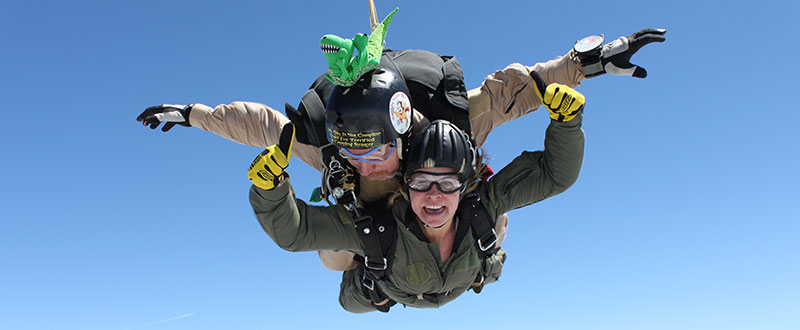
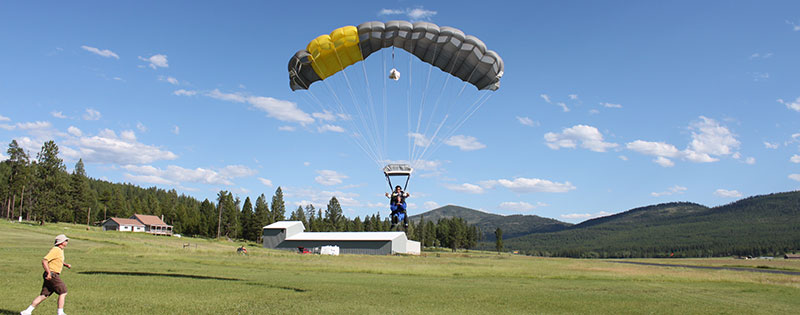

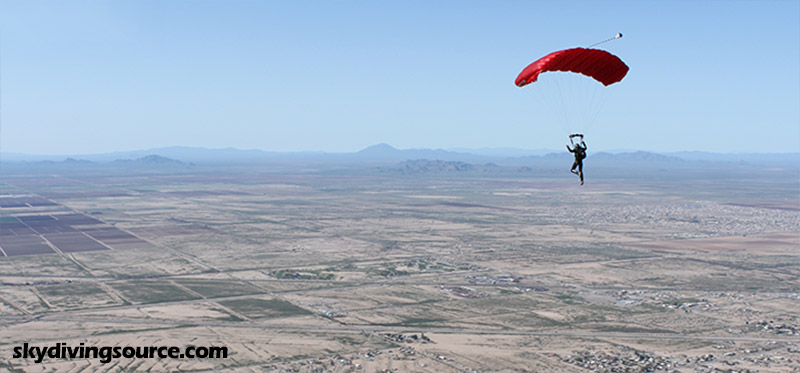
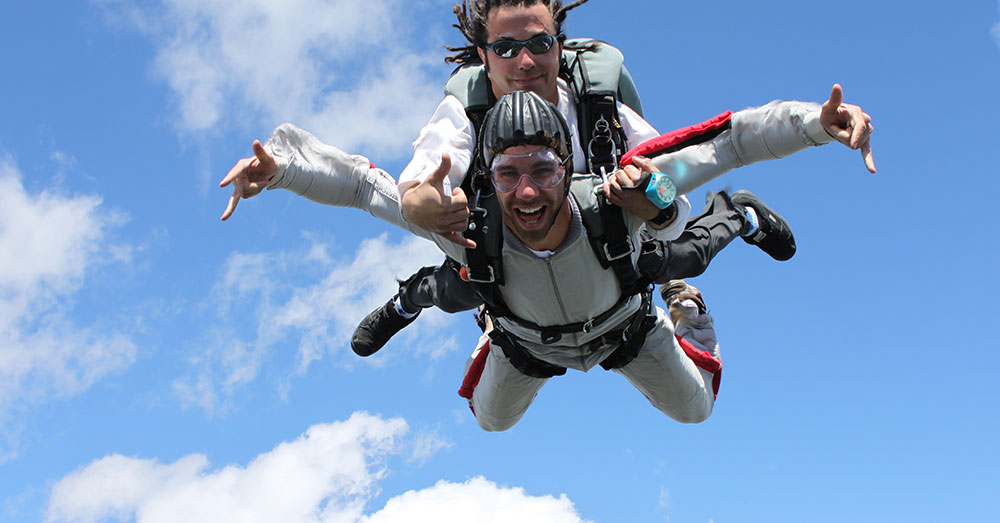
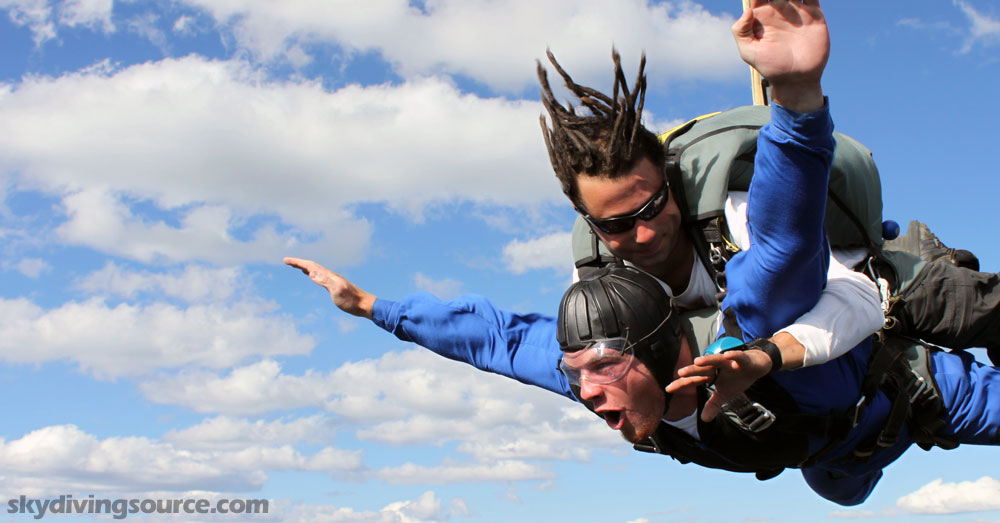
Hi
I would like to book for early next year
Can I pay off the tandem jump prior to jump or can it only. Be paid in full.
Hi Tina, your best to reach out to the dropzone directly to find out more about this. They may allow you to pay a deposit and then pay the rest upon arrival at the dropzone. Good luck!
I am in a wheelchair with little use of my legs
Can you accommodate me.
Hi Bonnie, you’re best reaching out to your local dropzone directly to find out more.
I am 80 yrs old 6ft1in 200lbs wondering if I might be able to make a tandem jump to add to my list.I was a paratrooper with the 101st airborne div. back in the early 60s and I would like to jump one more time.